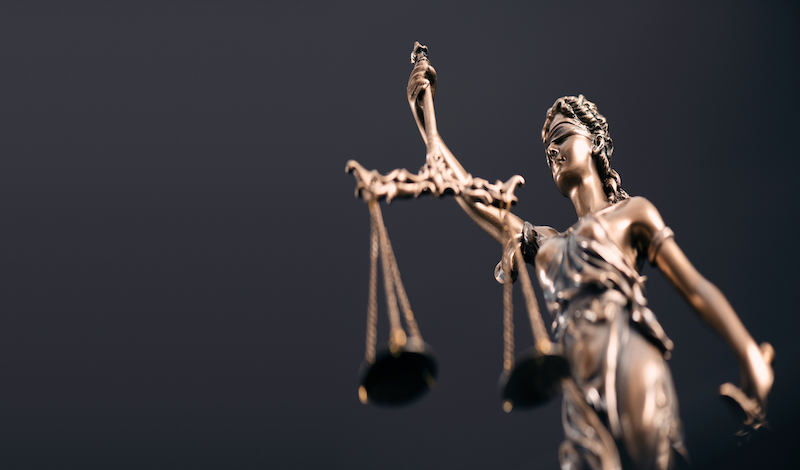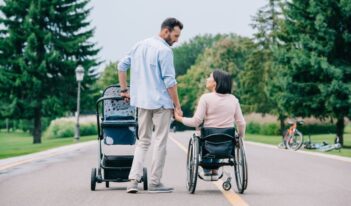
Misunderstandings about disability lawsuits subvert justice for people with disabilities.
Earlier this year, the New York Times Magazine profiled Albert Dytch, “The man who filed more than 180 disability lawsuits.” The article’s headline posed this question: “Is it profiteering—or justice?”
The article went on to provide a relatively nuanced portrait of Dytch, a 71-year old Californian with muscular dystrophy, but the headline exemplifies a problematic frame. It also offers a sharp reminder that even at a moment when disability-based discrimination features prominently in the news, misunderstandings abound about how lawmakers and administrators have tackled this discrimination—namely, incrementally, imperfectly, and with heavy reliance on the labor of disabled people themselves.
We attempt here to identify and correct three of the most troubling myths about this area of law and regulation.
Myth 1: To file a disability lawsuit against a place of public accommodation is to somehow take advantage of the system.
U.S. lawmakers designed many modern civil rights laws to rely substantially on private enforcement through individual lawsuits. Agencies such as the Equal Employment Opportunity Commission, the Department of Justice, and the Department of Education’s Office for Civil Rights play an important role in identifying and correcting civil rights violations, but the U.S. Congress also imagined that aggrieved individuals would go to court directly with their discrimination claims.
Indeed, as political scientist Sean Farhang has demonstrated, lawmakers from both political parties have had reasons to welcome private enforcement as they designed now-landmark civil rights laws. For instance, for politicians who had concerns about intrusive centralized bureaucracy, private enforcement offered the possibility of a leaner federal administrative state. For politicians who wanted to make sure civil rights enforcement was not overly dependent on future congressional appropriations or the whims of administrators, private lawsuits offered the prospect of “autopilot” enforcement.
The Americans with Disabilities Act (ADA) explicitly encourages private enforcement, albeit not to the degree that advocates of accessibility might prefer. Title III of the Act, dealing with public accommodations, authorizes affected parties to sue for injunctive relief. It gives prevailing parties the right to recover attorneys’ fees. And it does not require that prospective plaintiffs first “exhaust” potential administrative remedies before filing claims in court. In practice, courts have not been well disposed to Title III plaintiffs, as scholars such as Ruth Colker and Samuel Bagenstos have demonstrated. But there is no doubt that lawmakers contemplated such lawsuits—just as lawmakers contemplated private lawsuits to enforce the public accommodations title of the 1964 Civil Rights Act and the Fair Housing Act.
Notwithstanding the evidence of congressional intent, and notwithstanding decades of evidence that the ADA is significantly underenforced, popular narratives cast ADA litigation as inherently suspect. This “fear of the disability con,” as Doron Dorfman has framed the broader phenomenon, taints litigation about public accommodations. It also creates “unstable ground” for “the goal of building an accessible world,” as Dorfman and Mariela Yabo have observed.
Myth 2: The Americans with Disabilities Act is the source of predatory, serial litigation. It creates financial incentives for lawyers to recruit disabled plaintiffs with little to no connection with the program, service, benefit, or place of public accommodation targeted.
The fact that private actors continue to bring lawsuits challenging the accessibility of places of public accommodations shows that the ADA is doing what it is supposed to do. To the extent plaintiffs are winning monetary damages or securing large settlements, however, this does not flow from the text of the ADA. Congress designed the ADA’s enforcement structure to deputize private citizens—but Congress did not allow for the award of monetary damages to individual Title III plaintiffs, as the popular myth portrays. The monetary damages that Title III does allow are restricted to “pattern and practice” lawsuits that the Attorney General might file to address issues of public importance. Congress has also limited these damages to a maximum of $50,000 for a first violation and $100,000 for subsequent violations. Punitive damages are prohibited.
Three additional aspects of Congress’s enforcement scheme bear noting.
First, the ADA moved through congressional committees at the same time as proposed legislation to limit broader civil rights procedural rights and remedies and on the heels of largescale state tort reform movements. Narratives of litigation abuse were rampant in the national media and gaining steam in Washington, D.C., from the K Street lobby firms to the halls on Capitol Hill. In 1986, U.S. Senator Mitch McConnell (R-Ky.) cast the American public as a deranged lover, trapped in a “mad romance … with the civil litigation process.” Meanwhile, newspapers showcased public disdain for plaintiffs whose “greed has turned the temple of justice, long a hallowed place, into a pigsty”; they called upon lawmakers to “clean it up.” The influence of this rhetoric is apparent from Congress’s decision to limit plaintiffs’ remedies under Title III. In general, compromise was a main theme of the ADA’s legislative history, and a very “fragile compromise” was at the heart of Title III.
Some state laws, however, allow plaintiffs to recover damages for enforcing the state equivalent of Title III provisions. This framework opens the door for plaintiffs to allege claims of discrimination under both state and federal law and, if successful, to receive monetary compensation under state law. Florida law, for example, allows plaintiffs to recover compensatory and punitive damages up to $100,000. Florida also makes it a second degree misdemeanor to interfere with disabled individuals’ access to places of public accommodations, punishable by a maximum fine of $500 or up to sixty days imprisonment.
Second, it is misleading to suggest that, under the ADA, individuals with no connection to particular places of public accommodation may sue owners or operators of those places to enforce the law. Challenges to plaintiffs’ ability to sue often arise in Title III cases. Courts have generally found that plaintiffs must have some connection to the place of public accommodation to defeat such challenges, although courts’ exact phrasing varies. For example, in the Fifth Circuit, courts may require more than mere speculation about a plaintiff’s intent to access or return to a place of public accommodations, whereas, in the Ninth Circuit, courts have permitted plaintiffs to bring “test” cases under Title III to challenge inaccessible hotels.
Third, although lawyers may recover attorneys’ fees under Title III of the ADA, they are only entitled to do so in cases where a plaintiff is the “prevailing party.” This concept may seem sufficiently broad to allow most plaintiffs’ lawyers recovery of fees, but it certainly does not have that valence after the Supreme Court’s decision in Buckhannon Board and Home Care v. West Virginia Department of Health and Human Services. In that decision, the Court rejected the longstanding “catalyst theory” and narrowed recovery to only specific contexts where a judicial order produces the change sought by a plaintiff. The requirement of a “judicial imprimatur” established in Buckhannon reduces plaintiffs’ leverage in settlement negotiations and also weakens lawyers’ incentives to take on time intensive and costly public interest litigation. Thus, the notion of an unbridled windfall for plaintiffs or their lawyers overstates the actual law.
Together, these three contextual points make clear that serial plaintiffs and “drive-by lawsuits” are in some sense outgrowths of the law, but not in the ways that many public commentaries suggest. Public distaste for disability discrimination plaintiffs and their lawsuits appears to be tied to societal misunderstandings about the ADA, disability law, and the nuances of disability as a sociopolitical identity.
Myth 3: Legal reform efforts must focus on stopping or, at a minimum, delaying disability lawsuits. They cost too much and force small business owners, particularly those in minority communities, out of business.
In January 2017, former U.S. Representative Ted Poe (R-Texas) introduced H.R. 620, titled the “ADA Education and Reform Act,” in direct response to public narratives of serial ADA litigation. Notably, Poe framed this bill as a necessary compromise that would balance the interests of business owners against the interests of the disability lawsuit beneficiaries by affording business owners greater notice of alleged violations of Title III. It would impose additional procedural requirements on plaintiffs seeking to sue under Title III, such as providing written notice to owners with specific alleged violations and at least sixty days to cure them. It also would call for investment in alternative dispute resolution options. The bill passed the House by a vote of 225 to 192 in February 2018 but has remained dormant since.
Importantly, H.R. 620 was not the first time Congress showed interest in amending Title III of the ADA to place additional notice requirements on plaintiffs. Since 2000, Congress has heard testimony on several ADA reform and notification bills, all of which laid the groundwork for H.R. 620.
It is far from clear, however, that eliminating or postponing Title III enforcement actions is an appropriate solution to the problems that Representative Poe and others have perceived. Indeed, private business owners and operators have arguably been on “notice” of their obligations under the law for 31 years. In addition, studies suggest that accessibility violations persist and are hardly obscure.
To the extent that predatory lawsuits remain concerning, there are other avenues to pursue. One straightforward solution is to use procedural and professional responsibility rules to address any unethical actions by lawyers filing frivolous lawsuits. For example, the Federal Rules of Civil Procedure contain rules that require attorneys to attest to the non-frivolous nature of the lawsuit filed or face potential sanctions enumerated in Rule 11(c). These sanctions include monetary fines or payment of reasonable attorneys’ fees and other expenses related to the violation. And although a court may act in response to a Rule 11 motion from a party, it may also do so on its own accord, “with the goal to deter repetition of the conduct or comparable conduct by others similarly situated.” Aggrieved parties can also file disciplinary actions with state bar licensing authorities. Specific governing rules of ethics may vary by state, but most states have rules that prohibit lawyers from filing frivolous lawsuits.
If the perceived problem is less about the behavior of individual lawyers and more about systemic unfairness, again, there are a range of options that may be better than a bill like H.R. 620.
For example, if the provision of compensatory and punitive damages is the source of public discontent, the most obvious route to change is the state-level political process. State legislatures that currently encourage disability lawsuits could alter their laws.
If the issue is instead the cost of accessibility or regulated parties’ lack of understanding of their obligations, the best solution may be for the government to give more affirmative support rather than to weaken Title III’s enforcement scheme. Such affirmative support could come in the form of additional tax subsidies for accommodations, more robust guidance, or greater investment in education campaigns.
At a minimum, critics should note the perils of seeking to scale back private enforcement without also taking measures to enhance enforcement overall. Fifteen years ago, Sam Bagenstos showed how the imposition of limitations on civil rights remedies did not simply decrease the number of cases brought; it also affected the character of the cases filed, in a way that suggested a dangerous, self-perpetuating loop. As he noted, “concern with abusive litigation motivates the adoption of limitations on remedies; those limitations lead plaintiffs’ lawyers to engage in litigation conduct that appears even more abusive; the newly energized perception of abuse motivates adoption of even more limitations; and so on.”
* * *
What does it mean to file a disability-based antidiscrimination lawsuit, or even a series of such lawsuits, in the United States today? “Is it profiteering—or justice?” the New York Times would have us ask. Is it either profiteering or justice? And why are these two frameworks our only choices?
The term “profiteering” connotes not only greed, but also a sort of hard-hearted exploitation—as if the Albert Dytch’s of the world are withholding some scarce commodity from people in need and parting with it only at an egregiously high price.
But the disabled plaintiffs are the ones who lack what lawmakers have said they deserve. And to the extent they are demanding a price, it is a price that the government has set—and that the government has the power to change, or to charge to different actors.
Yes, litigants like Dytch—and the lawyers representing them—may benefit financially from the suits they file, but so, too, do litigants who sue to enforce fair housing laws or the False Claims Act. Why does the “profiteering” label seem to land on one category of litigants but not others?
As for justice, private lawsuits are a vehicle for pursuing that noble goal, and one that democratically elected lawmakers have chosen. But few disability rights advocates would confuse these lawsuits with justice itself. Justice would require reckoning with why so many public venues and services remain inaccessible to significant segments of the population. It would also require reckoning with why our most prominent public narrators so often treat inclusion as a cost, leveled by the disabled few and charged to the morally innocent.
This essay is part of a five-part series, entitled Regulation and Disability Rights.





